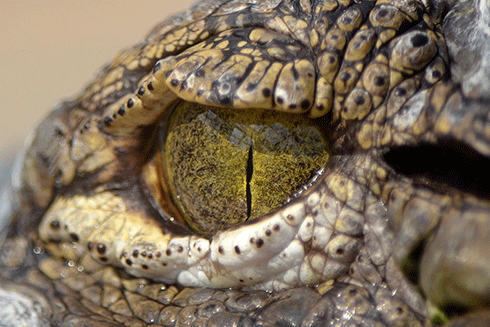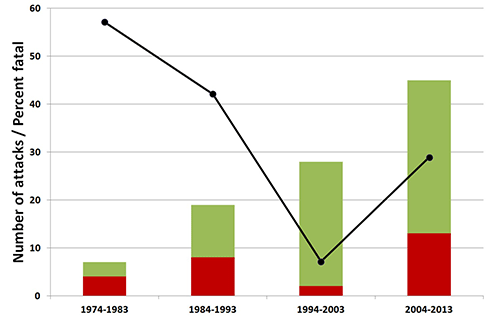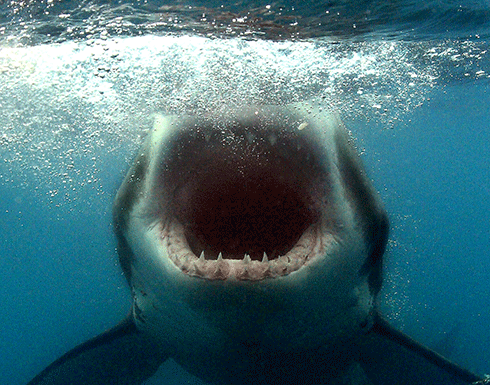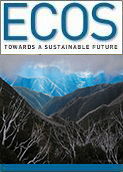
|
Published: 6 January 2014
Croc attacks: a new website with bite
Crocodiles have a rather off-putting character trait: they bite. It’s fair to say few people like being bitten.

|
|
Expert eye: crocodiles have evolved to ambush their prey, lying in wait for fish or land animals to come close before rushing to attack. Credit: Russavia/Wikimedia Commons
|
We like being eaten even less, and reserve our most morbid fears for creatures that dare to consume us. Many find it quite unnerving to live and work in areas where humans are demonstrably not at the top of the food chain.
It is surprising that we’ve done so little work to track clashes between crocodiles and humans, including where, when and why they occur. Late last year, Big Gecko and Charles Darwin University launched CrocBITE , a worldwide crocodilian attack database that does exactly that.
With nearly 2000 incidents recorded across 16 species, 50 countries and 150 years, it provides a strong baseline to better understand croc attack trends and risk factors.

|
|
Fatal (F; red) and non-fatal (NF; olive) attack incidents across 16 species from 2008 to 2013. Nile crocodile attacks are likely under-represented due to limited record-keeping. Credit: CrocBITE
|
How is Australia doing?
Crocodile attacks are increasing in many countries, but some places are doing a better job than others at keeping them in check. Since 1971, Australia has witnessed 99 attacks on people by saltwater crocodiles, of which 27 per cent were fatal. On average that’s around 2.3 attacks per year over four decades, of which 0.6 were fatal. That’s pretty good going for a country with the highest river densities of saltwater crocodiles in the world, and an active human population that spends a lot of time in and around water.
Although the rate of attacks has increased in the last decade (4.5 attacks per year since 2004), the fatality rate has actually fallen since the 1970s and 1980s from 57 per cent (1974 to 1983) to 29 per cent (2004 to 2013).
This probably reflects the greater proportion of crocodiles in the size range (around 3 m) that typically lead to non-fatal attacks. With an ongoing increase in the proportion of very large crocodiles, we might expect a greater proportion of fatal attacks in the future.
Australia’s strong and mature crocodile management program can take a lot of credit for keeping fatalities low. Management in other countries within the saltwater crocodile’s range still has a long way to go, as evidenced by much higher attack and fatality rates (for example, since 2007, Timor Leste has had 53 attacks, 72 per cent fatal; Sumatra has had 107 attacks, 49 per cent fatal).
It’s not just humans that suffer from conflict. We kill around 250–300 crocodiles around Darwin each year to reduce risks to people. Queensland is starting to adopt a similar approach. This is a tiny proportion of the total crocodile population, but we still have a limited understanding of how removing different sized crocodiles might influence croc behaviour in ways that could affect our safety.
Croc-free zones
Crocodiles are survivors. They have been around for well over 100 million years, and their ability to survive is strongly correlated with the quality of their remaining habitat.
The trouble is, as our towns and cities continue to expand, we’re increasingly coming into conflict with creatures that are as determined as us to survive.
In Queensland, the state government has passed laws allowing some areas to be declared crocodile ‘exclusion zones’, where crocodiles will not be tolerated, with the option of putting in barriers to stop them returning.
In zones considered to be at higher risk of ‘crocodile-human interaction’ , such as Cairns and surrounding beaches and rivers, rangers have been catching and removing crocs bigger than 2 metres long.
Queensland rangers show their technique of wrangling large crocs in the Queenland’s far north.
Credit: ABC News
Living with killers
Crocodile conservation has been a victim of its own success in many parts of northern Australia.
From uncontrolled exploitation after the Second World War, to blanket protection from the early 1970s, our conservation strategies have continually needed to adapt.
Once protected populations became numerous enough to result in more frequent crocodile attacks, public support quickly eroded. Management shifted from protection to sustainable use , with the promise of profit as a conservation incentive.
Someone once told me they hate crocodiles with a passion, but they love their community with equal passion, and if having crocodiles supports local jobs, then they’re OK as long as they ‘toe the line.
The trouble is, crocodiles toe no line. They are wild animals subject to natural behaviour and the mathematical beauty of their population ecology.
The more crocodiles there are around people, the greater the likelihood of someone stumbling across their path – occasionally with fatal results.
People will only tolerate so much. Attacks propagate fear, no matter how small the actual risk of being attacked. Once the pressure to “do something” reaches a sympathetic political ear, crocodiles come off second-best.
Despite this, pressure to change may be essential for the continued successful management of crocodiles in northern Australia, based on sound science and pragmatic compromise between competing interests.
Learning from sharks
The new CrocBITE website and database encourages contributions from individuals and agencies around the world. We have more than 50 data contributors so far, and we have designed it to be citizen science friendly , to attract data from diverse sources.
CrocBITE is inspired by the success of the International Shark Attack File, which since 1958 has provided information and advice on shark attacks worldwide. Based in Florida and run by expert shark biologists, it stores more than 3400 individual investigations into shark attacks globally from the mid-1500s up to the present.
Partly thanks to that database, we now have a more mature understanding of shark ecology and behaviour, as well as analysis of circumstances leading to shark attacks around the world, and even the benefits of having sharks around.
Before CrocBITE, we did not have a similarly comprehensive database of crocodile attacks, making it difficult to properly analyse where and why they have occurred.
However, translating this knowledge into good policy for handling shark and crocodile attacks still remains a challenge, as the responses to recent shark attacks in WA and NSW demonstrate. The science tells us that culling sharks is the wrong approach, especially where endangered species are involved. Unfortunately, culling is much easier to sell politically.
Does culling work for crocodiles? It is undoubtedly easier to target specific problem crocodiles within a management area, and the Northern Territory has demonstrated that a pro-active removal strategy has benefits for public awareness and reducing risk. Yet it doesn’t change the simple fact that it’s dangerous to swim in crocodile habitat. Culling crocs will not eliminate risk.
Crocodiles and sharks elicit similar strong emotions. Ensuring the best results will require hard scientific and political work. Ultimately, the most effective strategy for staying safe is common sense.
Adam Britton is a partner at Big Gecko, a consultancy that specialises in crocodile management, education and training. He is also a Senior Research Associate at Charles Darwin University (CDU) in Darwin. Dr Britton has been doing crocodile-related research and conservation projects for around 18 years. Andrew Campbell is the Director of the Research School for the Environment and Livelihoods at Charles Darwin University. Professor Campbell has been involved in natural resource management in Australia for 25 years, with senior policy roles in land, water and biodiversity management. This article was originally published at The Conversation.





